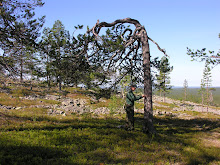Tuoreessa kansainvälisessä tutkimuksessa kehitettiin uusi menetelmä maailmanlaajuiseen metsien kartoitukseen satelliittikuvien avulla.
Menetelmä huomioi entistä tarkemmin metsien rakenteen vaikutuksen
satelliittien mittaamaan metsien heijastukseen. Tutkimus julkaistaan joulukuun alussa yhdessä maailman arvovaltaisimmista tieteellisistä julkaisusarjoista, Yhdysvaltain tiedeakatemian lehdessä (Proceedings of the
National Academy of Sciences of the United States of America, PNAS).
Helsingin yliopiston tutkijat ovat olleet keskeisessä roolissa tutkimuksen
suunnittelussa ja toteutuksessa.
Tutkimus kumoaa myös vallalla olleen käsityksen siitä, että kasvillisuudessa oleva typpi vaikuttaisi kasvillisuuden heijastamaan auringonsäteilyyn ja sitä kautta maapallon ilmastoon. Tutkimuksessa osoitettiin, että tämä väite perustui aineistojen virheelliseen tulkintaan.
-Uudet tulokset sen sijaan osoittavat, että metsän lajikoostumus ja latvusrakenne määräävät heijastuneen säteilyn suuruuden, tarkentaa tutkimuksessa mukana ollut Helsingin yliopiston metsänarvioimistieteen professori Pauline Stenberg.
Tutkimuksessa tarkasteltiin kasvillisuuden heijastamaa lyhytaaltoista säteilyä lauhkealla ja havumetsävyöhykkeellä.
-Metsän heijastama säteily riippui selvästi siitä, kuinka paljon lehti- tai havupuita alueella kasvoi. Lehtimetsät heijastivat huomattavasti enemmän kuin havumetsät, selittää akatemiatutkija Miina Rautiainen Helsingin yliopiston metsätieteiden laitokselta.
-Tuloksillamme on merkittävä rooli uusien hyperspektristen satelliittimissioiden suunnittelussa ja toteutuksessa Yhdysvalloissa ja Euroopassa, kertoo Helsingin yliopiston kaukokartoituksen dosentti Matti Mõttus.
Tulevan vuosikymmenen aikana on tarkoitus laukaista useita uusia satelliitteja, joissa on maapallon kasvillisuuden tilaa seuraavia hyperspektrisiä mittalaitteita. Näiden mittalaitteiden tuottamien aineistojen tulkintaan tarvitaan laskentamenetelmiä, joita on julkaistu tässä artikkelissa.
Artikkeli on luettavissa verkossa: http://www.pnas.org/content/early/2012/12/03/1210196109). Artikkeli on syntynyt Bostonin yliopiston ja Helsingin yliopiston yhteisen, NASA:n rahoittaman tutkimusprojektin puitteissa.
Tutkimus kumoaa myös vallalla olleen käsityksen siitä, että kasvillisuudessa oleva typpi vaikuttaisi kasvillisuuden heijastamaan auringonsäteilyyn ja sitä kautta maapallon ilmastoon. Tutkimuksessa osoitettiin, että tämä väite perustui aineistojen virheelliseen tulkintaan.
-Uudet tulokset sen sijaan osoittavat, että metsän lajikoostumus ja latvusrakenne määräävät heijastuneen säteilyn suuruuden, tarkentaa tutkimuksessa mukana ollut Helsingin yliopiston metsänarvioimistieteen professori Pauline Stenberg.
Tutkimuksessa tarkasteltiin kasvillisuuden heijastamaa lyhytaaltoista säteilyä lauhkealla ja havumetsävyöhykkeellä.
-Metsän heijastama säteily riippui selvästi siitä, kuinka paljon lehti- tai havupuita alueella kasvoi. Lehtimetsät heijastivat huomattavasti enemmän kuin havumetsät, selittää akatemiatutkija Miina Rautiainen Helsingin yliopiston metsätieteiden laitokselta.
-Tuloksillamme on merkittävä rooli uusien hyperspektristen satelliittimissioiden suunnittelussa ja toteutuksessa Yhdysvalloissa ja Euroopassa, kertoo Helsingin yliopiston kaukokartoituksen dosentti Matti Mõttus.
Tulevan vuosikymmenen aikana on tarkoitus laukaista useita uusia satelliitteja, joissa on maapallon kasvillisuuden tilaa seuraavia hyperspektrisiä mittalaitteita. Näiden mittalaitteiden tuottamien aineistojen tulkintaan tarvitaan laskentamenetelmiä, joita on julkaistu tässä artikkelissa.
Artikkeli on luettavissa verkossa: http://www.pnas.org/content/early/2012/12/03/1210196109). Artikkeli on syntynyt Bostonin yliopiston ja Helsingin yliopiston yhteisen, NASA:n rahoittaman tutkimusprojektin puitteissa.

